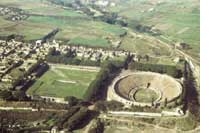
People in Roman times went to the Amphitheater to see plays and gladiator fights. Some amphitheaters couldbefilled with water so that ship battles could be fought. Sometimes circuses with acrobats and animal actswould stage shows in the Amphitheater. This large amphitheater is one of several in Pompeii.
古羅馬的人們?nèi)A形劇場(chǎng)觀看演出和角斗士的表演。一些這樣的圓形競(jìng)技場(chǎng)還會(huì)被注滿(mǎn)水以便表演海上作戰(zhàn)的船只能夠航行。有時(shí)候表?yè)P(yáng)走鋼絲和動(dòng)物秀的馬戲團(tuán)也會(huì)在圓形劇場(chǎng)演出。圖上所示就是龐貝城幾座較大的劇場(chǎng)之一。
This is considered to be the world's oldest known amphitheater. About the size of a modern football stadium,it had a seating capacity of 12,000 spectators. It was here in 59 A.D. that a riot broke out during a competition with a rival city. The death of many spectators caused the Roman Senate to forbid any games inthe Pompeii Amphitheater for the next 10 years.
它被認(rèn)為是世界上最古老的圓形競(jìng)技場(chǎng)。大致相當(dāng)于一個(gè)現(xiàn)代的露天足球場(chǎng)那么大,能容納12000觀眾的坐席。公元59年,在與另一個(gè)敵對(duì)城市的競(jìng)技比賽中,這里發(fā)生了一次暴亂。許多觀眾在暴亂中死亡,這使得羅馬參議院禁止龐貝的競(jìng)技場(chǎng)舉行任何比賽長(zhǎng)達(dá)10年之久。
The huge square area, called the Palaestra,to the southwest of the Amphitheater was built in the days of Augustus Caesar. This Palaestra served as a gymnasium and a place to indoctrinate the young people in Augustan ideals. In the center was a huge swimming pool, sloping from 3 feet to 8 feet deep.
競(jìng)技場(chǎng)旁邊巨大的廣場(chǎng)區(qū)域,叫做“派拉斯塔”,建于奧古斯都-愷撒時(shí)期,在劇場(chǎng)的西南方向。派拉斯塔的作用像一個(gè)體育訓(xùn)練館。建造它的目的是為了給青年人灌輸奧古斯都的理念提供一個(gè)場(chǎng)所。它中間的區(qū)域是個(gè)大型游泳池,最淺的地方深3英尺,最深的地方深8英尺。











